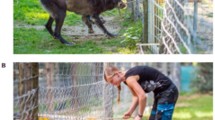Abstract
Humans show greater affiliation with people who are behaviorally synchronized with them but little is known about the impact of synchronization at an interspecific level. We, therefore, explored whether the synchronization of humans with dogs affects dogs’ human preferences. Pet dogs were exposed to two unfamiliar persons: one synchronized her walking behavior with them and one walked randomly. In a preference test, molossoids exhibited a clear social preference for the synchronized person, unlike shepherds. We conclude that pet dogs show a greater affiliation with humans who mimic their walking behavior, although genetic selection modulates this propensity. Behavioral synchronization, therefore, acts as a social glue in dogs too. It is the first time that such a human-like ability has been highlighted in domesticated canids at an interspecific level. Implications for the evolution of behavioral synchronization are discussed.


Similar content being viewed by others
Data Availability
The data associated with this research are available at [link].
References
Asendorpf JB, Warkentin V, Baudonnière PM (1996) Self-awareness and other-awareness II: mirror-self recognition, social contingency awareness, and synchronic imitation. Dev Psychol 32(2):313–321
Autier-Drian D, Deputte BL, Chalvet-Monfray K, Coulon M, Mounier L (2013) Visual discrimination of species in dogs (Canis familiaris). Anim Cogn 16(4):637–651
Bornstein RF, D’Agostino PR (1992) Stimulus recognition and the mere exposure effect. J Pers Soc Psychol 63:545–552
Charan J, Biswas T (2013) How to calculate sample size for different study designs in medical research? Ind J Psychol Med 35:121–126
Chartrand TL, Bargh JA (1999) The chameleon effect: the perception-behavior link and social interaction. J Pers Soc Psychol 76(6):893–910
Chartrand TL, Lakin JL (2013) The antecedents and consequences of human behavioral mimicry. Ann Rev Psychol 64:285308
Cirelli LK, Wan SJ, Trainor LJ (2014) Fourteen-month-old infants use interpersonal synchrony as a cue to direct helpfulness. Phil Trans R Soc Lond B: Biol Sci 369:20130400
Cirelli LK, Wan SJ, Trainor LJ (2016) Social effects of movement synchrony: increased infant helpfulness only transfers to affiliates of synchronously moving partners. Infancy 21:807–821
Condon WS, Sander LW (1974) Synchrony demonstrated between movements of the neonate and adult speech. Child Dev 45:456–462
Deldalle S, Gaunet F (2014) Effects of two training methods on stress-related behaviors of the dog (Canis familiaris) and on the dog-owner relationship. J Vet Behav Clin Appl Res 9(2):56–65
Duffy DL, Hsu Y, Serpell JA (2008) Breed differences in canine aggression. Appl Anim Behav Sci 114:441–460
Duranton C, Gaunet F (2015) Canis sensitivus: affiliation and dogs’ sensitivity to others’ behavior as the basis for synchronization with humans? J Vet Behav Clin Appl Res 10:513–524
Duranton C, Gaunet F (2016) Behavioural synchronization from an ethological perspective: short overview of its adaptive values. Adapt Behav 24(3):181191
Duranton C, Bedossa T, Gaunet F (2016) When facing an unfamiliar person, pet dogs present social referencing based on their owner’s direction of movement alone. Anim Behav 113:147156
Duranton C, Bedossa T, Gaunet F (2017a) Do shelter dogs engage in social referencing with their caregiver in an approach paradigm? An exploratory study. Appl Anim Behav Sci 189:57–65
Duranton C, Bedossa T, Gaunet F (2017b) Interspecific behavioural synchronization: dogs exhibit locomotor synchrony with humans. Sci Rep 7:12384
Duranton C, Bedossa T, Gaunet F (2018) Pet dogs synchronize their walking pace with that of their owners in open outdoor areas. Anim Cogn 21(2):219–226
Ebstrein RP, Israel S, Hong Chew S, Zhong S, Knafo A (2010) Genetics of human social behavior. Neuron 65(6):831–844
Eken Asp H, Fikse WF, Nilsson K, Strandberg E (2015) Breed differences in everyday behavior of dogs. Appl Anim Behav Sci 169:69–77
Frantz LAF, Mullin VE, Pionnier-Capitan M, Lebrasseur O, Ollivier M, Perri A, Larson G (2016) Genomic and archaeological evidence suggests a dual origin of domestic dogs. Science 352(6290):1228–1231
Gaunet F, El Massioui F (2014) Marked referential communicative behaviours, but no differentiation of the “knowledge state” of humans in untrained pet dogs versus 1-year-old infants. Anim Cogn 17(5):1137–1147
Guéguen N, Jacob C, Martin A (2009) Mimicry in social interaction: its effect on human judgment and behavior. Eur J Soc Sci 8(2):253259
Hare B, Brown M, Williamson C, Tomasello M (2002) The domestication of social cognition in dogs. Science 298:1634–1636
Harmon-Jones E, Allen JJB (2001) The role of affect in the mere exposure effect: evidence from psychophysiological and individual differences approaches. Pers Soc Psychol Bull 27(7):889–898
Hill WF (1978) Effects of mere exposure on preferences in nonhuman mammals. Psychol Bull 85(6):1177–1198
Jacob C, Guéguen N (2013) The effect of employees’ verbal mimicry. Int J Hosp Manag 35:109–111
Kendon A (1970) Movement coordination in social interaction: Some examples described. Acta Psychol 32:100–125
King AJ, Cowlishaw G (2009) All together now: behavioural synchrony in baboons. Anim Behav 78:1381–1387
Kirschner S, Tomasello M (2010) Joint music making promotes prosocial behaviour in 4-year-old children. Evol Hum Behav 31:354–364
Kis A, Bence M, Lakatos G, Pergel E, Turcsán B, Pluijmakers J, Vas J, Elek Z, Brúder I, Földi L, Sasvári-Székely M, Miklósi Á, Rónai Z, Kubinyi E (2014) Oxytocin receptor gene polymorphisms are associated with human directed social behavior in dogs (Canis familiaris). PLoS One 9:e83993
Lakin JL, Jefferis VE, Cheng CM, Chartrand TL (2003) The chameleon effect as social glue: evidence for the evolutionary significance of nonconscious mimicry. J Nonverb Behav 27:145–162
Ludbrook J, Dudley H (1998) Why permutation tests are superior to t and F rests in biomedical research. Am Stat 52(2):127–132
Marshall-Pescini S, Dale R, Quervel-Chaumette M, Range F (2016) Critical issues in experimental studies of prosociality in non-human species. Anim Cogn 19(4):679–705
Mehrkam LR, Wynne CDL (2014) Behavioral differences among breeds of domestic dogs (Canis lupus familiaris): current status of the science. Appl Anim Behav Sci 155:12–27
Miklósi Á, Topál J, Csányi V (2007) Big thoughts in small brains? Dogs as a model for understanding human social cognition. Cogn Neurosci Neuropsychol 18(5):467–471
Muller BCN, Maaskant AJ, van Baaren RB, Dijksterhuis A (2012) Prosocial consequences of imitation. Psychol Rep 110(3):891–898
Nagasawa M, Mitsui S, En S, Ohtani N, Ohta M, Sakuma Y, Onaka T, Mogi K, Kikusui T (2015) Oxytocin-gaze positive loop and the coevolution of human-dog bonds. Science 348(6232):333–336
Passalacqua C, Marshall-Pescini S, Barnard S, Lakatos G, Valsecchi P, Prato-Previde E (2011) Human-directed gazing behaviour in puppies and adult dogs, Canis lupus familiaris. Anim Behav 82:1043–1050
Paukner A, Suomi SJ, Visalberghi E, Ferrari PF (2009) Capuchin monkeys display affiliation toward humans who imitate them. Science 325:880–883
Quervel-Chaumette M, Dale R, Marshall-Pescini S, Range F (2016a) Familiarity affects other-regarding preferences in pet dogs. Sci Rep 5:18102
Quervel-Chaumette M, Mainix G, Range F, Marshall-Pescini S (2016b) Dogs do not show pro-social preferences towards humans. Front Psychol 7: 1416.
Richardson MJ, Marsh KL, Isenhower RW, Goodman JRL, Schmidt RC (2007) Rocking together: dynamics of intentional and unintentional interpersonal coordination. Hum Mov Sci 26:867–891
Richardson DC, Dale R, Shockley K (2008) Synchrony and swing in conversation: coordination, temporal dynamics, and communication. Oxford University Press, Oxford
Sanchez-Burks J, Bartel CA, Blount S (2000) Performance in intercultural interactions at work: cross-cultural differences in response to behavioral mirroring. J Appl Psychol 94(1):216–223
Starling MJ, Branson N, Thomson PC, McGreevy PD (2013) Age, sex and reproductive status affect boldness in dogs. Vet J 197:868–872
Svartberg K (2006) Breed-typical behaviour in dogs: historical remnants or recent constructs. Appl Anim Behav Sci 96:293–313
Tunçgenç B, Cohen E (2016) Movement synchrony forges social bonds across group divides. Front Psychol 7:782
Tunçgenç B, Cohen E, Fawcett C (2015) Rock with me: The role of movement synchrony in infants’ social and nonsocial choices. Child Dev 86(3):976–984
Turcsán B, Kubinyi E, Miklósi Á (2011) Trainability and boldness traits differ between dog breed clusters based on conventional breed categories and genetic relatedness. Appl Anim Behav Sci 132:61–70
van Baaren RB, Holland RW, Steenaert B, van Knippenberg A (2003) Mimicry for money: behavioral consequences of imitation. J Exp Soc Psychol 39(4):393–398
van Baaren RB, Holland RW, Kawakami K, van Knippenberg A (2004) Mimicry and prosocial behavior. Psychol Sci 15(1):71–74
van Ulzen NR, Lamoth CJC, Daffertshofer A, Semin GR, Beek PJ (2008) Characteristic of instructed and uninstructed interpersonal coordination while walking side-by-side. Neurosci Lett 432:88–93
Vas J, Topál J, Gácsi M, Miklósi Á, Csányi V (2005) A friend or an enemy? Dogs’ reaction to an unfamiliar person showing behavioural cues of threat and friendliness at different times. Appl Anim Behav Sci 94:99–115
Voss K, Galeandro L, Wiestner T, Haessif M, Montavon PM (2010) Relationships of body weight, body size, subject velocity, and vertical ground reaction forces in trotting dogs. Vet Surg 39(7):863–869
Xavier J, Tilmont E, Bonnot O (2013) Children’s synchrony and rhythmicity in imitation of peers: toward a developmental model of empathy. J Phys Paris 107(4):291–297
Zajonc RB (1968) Attitudinal effects of mere exposure. J Pers Soc Psychol Monogr 9(2:pt. 2):1–27
Acknowledgements
The authors are grateful to Célicia Lecomte for her drawings and Elodie Losserand for the reliability coding. We are also grateful to Dr. Jessica Rock for her helpful edits and suggestions. We finally thank the owners who volunteered to take part in the study. This work was funded by the National Association for Research and Technology, the Help for Old Animals (AVA) association, the French National Center for Scientific Research, and Aix-Marseille University.
Author information
Authors and Affiliations
Corresponding author
Ethics declarations
Conflict of interest
The authors declare that they have no conflict of interest.
Additional information
Publisher’s Note
Springer Nature remains neutral with regard to jurisdictional claims in published maps and institutional affiliations.
Rights and permissions
About this article
Cite this article
Duranton, C., Bedossa, T. & Gaunet, F. Pet dogs exhibit social preference for people who synchronize with them: what does it tell us about the evolution of behavioral synchronization?. Anim Cogn 22, 243–250 (2019). https://doi.org/10.1007/s10071-019-01241-w
Received:
Revised:
Accepted:
Published:
Issue Date:
DOI: https://doi.org/10.1007/s10071-019-01241-w




